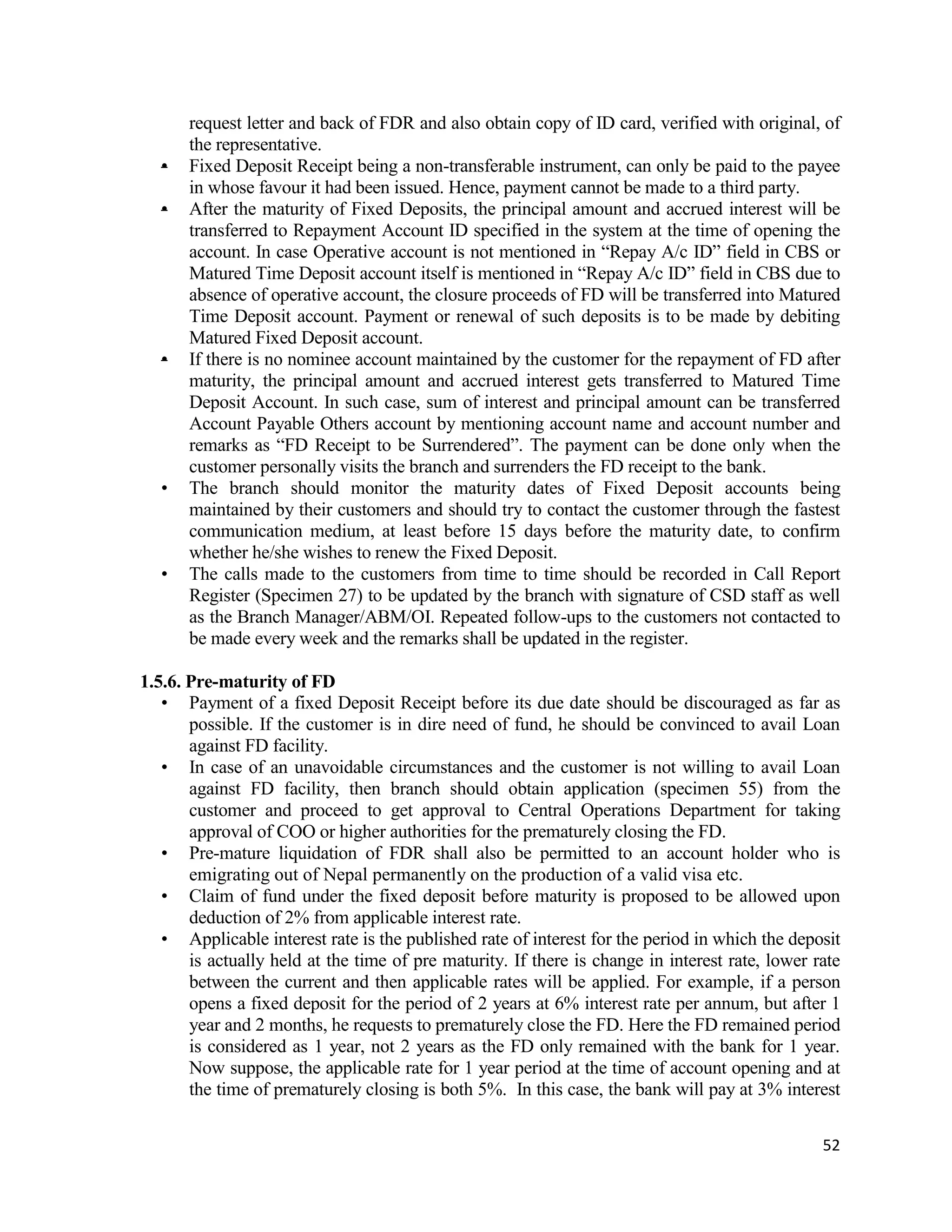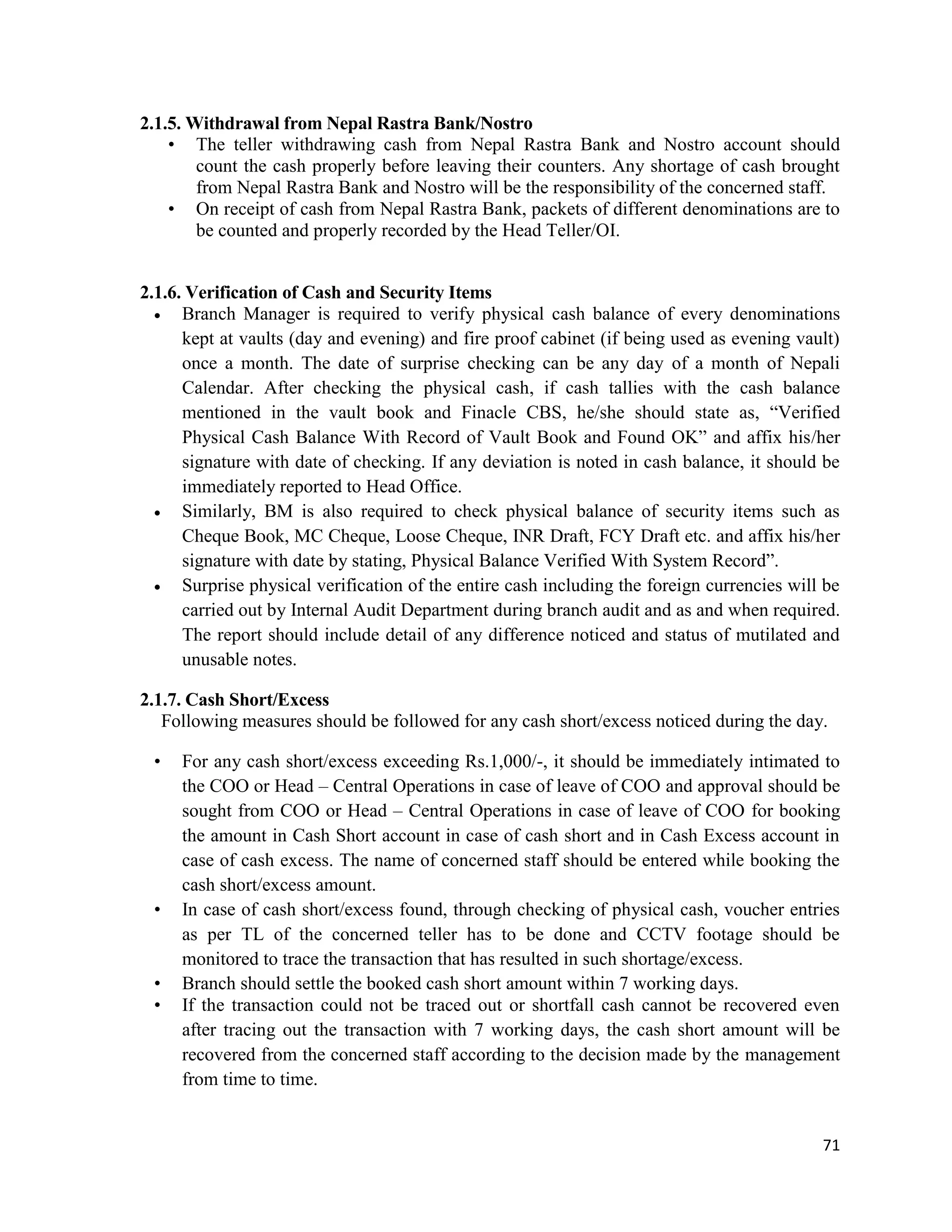This document provides the procedures for various operations in the bank, including customer service, account opening and maintenance, cash transactions, remittance, clearing, and more. It outlines the roles and responsibilities of different departments and staff. The purpose is to have standardized processes that comply with regulatory requirements and help staff address customer needs effectively. The key areas covered include customer service, account opening and closing procedures, cash management, payment instruments, clearing processes, and more.












































![38
1.3.13. Good for Payment (GFP) Cheques
A cheque backed by a bank‟s surety for payment is called as Good for Payment (GFP)
Cheques. When a cheque is marked with a “Good for Payment” stamp with authorized
signatures of the Bank‟s signatories, it is called a “Good for Payment Cheque”. Such
marking of the cheque means that the cheque will be honored within the validity period
irrevocably and unconditionally on presentation to any branches of the Bank.
1.3.13.1. Procedure to mark a cheque as “Good for Payment”
The customer submits an application (Specimen 14) along with the cheque to be marked
as Good for Payment.
• Signature of the accountholder on the application has to be verified. Then signature and
details mentioned in the cheques have to be verified to ensure its validity.
• Entry of the cheque to be made in the Finacle System. Once details are updated and
verified by user and after verification, following entry will be executed by the system
itself.
Customer‟s AC Dr.
Good for Payment Cheque AC Cr.
Customer‟s AC Dr.
GFP Issuance Charge AC Cr.
After ensuring that the cheque amount is transferred in the Good for Payment Account,
“Good for Payment” stamp is to be affixed on the cheque. Similarly, two authorized
signatories of the branch should affix their signatures by mentioning their signature no. of
Signature, Name, Designation and issued Date on the back side of the cheque. Likewise,
branch stamp is also to be affixed near the authorized signatures without fail.
• Branches should generate System Printed advice after issuing Good for Payment cheque.
One copy should be issued to customer and another copy should be kept by branches.
• Photocopy of the Cheque is to be taken and kept in record.
• Only Account payee cheque can be marked as Good for Payment Cheque. Hence, all the
Good for Payment Cheque must be marked Account Payee, i.e. payable only in the
account of payee.
• Post-dated (bearing a future date) cheques cannot be marked as Good for Payment.
• Separate register (Specimen 15) should be kept for recording issue of GFP Cheques.
Note:
Branches should check and confirm the validity of the GFP cheques before making its
payment [i.e. Credit as well as Debit transactions made in the GFP account is to be
checked]. Further, branches should reconcile the GFP accounts of their respective
branches on fortnightly basis. Any deviation shall be immediately reported to Central
Operations Department.](https://image.slidesharecdn.com/1663789117187operationsmanual2022draft-230925160458-8e86f6b0/75/1663789117187Operations-Manual-2022-Draft-pdf-45-2048.jpg)




![43
• The account will be operated by the Guardian of the minor until the minor into major or
attains the age of 18 years.
• Documents required to open an account of a minor include Birth Certificate and 2 PP
size photographs of the minor, Citizenship Certificate or Passport and 2 PP size
photographs of a Guardian. If the minor has crossed 16 years of age and has also
obtained Citizenship Certificate, it can also be accepted instead of Birth Certificate.
Separate KYC form of both minor and guardian is to be obtained.
• If guardian is not the parents of the minor, recommendation letter from Ward Office is
to be obtained. The recommendation letter should mention the relationship between the
proposed guardian and the minor and the reason why the parents could not become
guardian for the account.
• The guardian details in the Account Opening Form should be properly filled disclosing
the relationship between the minor and the guardian.
• Caption should be inputted in the Specimen Signature Card as “Minor Account” as well
as in the image of the system.
• No OD/ Loan facility is to be allowed in this account.
• Branches should update minor turning major date in SVS/Signature Module in Minor
account [i.e. Date of expiry of Minor accounts] while opening the Minor accounts.
• Customer should be duly informed that account will be debit restricted once the minor
turns into major.
• When minor turns into major or attains 18 years of age, the existing a/c shall be closed
in case of Muna Bachat account. In case of other accounts, the same account can be
continued by obtaining complete AOF and KYC filled by the account holder and
obtaining his/her citizenship certificate and latest photograph.
• If the account holder is out of contact, then the account should be debit frozen with
complete remark mentioning “Minority Ceased”.
• No transaction should be allowed on the account once the minor turns into a major,
until the minor submits citizenship certificate, AOF and KYC for operating the account
through the signature of the account holder. A request letter signed by both the account
holder and the guardian is to be obtained for changing the operating authority of the
account .
• In case of emergency, the guardian may request in writing for withdrawing some
money from the account balance. If the branch deems the request as genuine and
justified, they can forward the request to Central Operations Department for taking
approval from COO or higher authorities.
1.3.18. Accounts of illiterate person
The bank can open accounts of an illiterate person with their thumb impression.
Precaution is to be taken and following points to be noted while opening and operating
account of Illiterate person.
• If any illiterate person desires to open an account, his/her both Right and Left thumb
print should be taken in place of signature. These thumb print should be distinguishable
i.e. Right and Left should be marked with the thumb print.](https://image.slidesharecdn.com/1663789117187operationsmanual2022draft-230925160458-8e86f6b0/75/1663789117187Operations-Manual-2022-Draft-pdf-50-2048.jpg)




























![72
• The amount booked under Cash Excess account should never be debited for adjusting
cash shortage found in teller account on any day.
• At the end of Fiscal Year, the balance of Cash Excess booked shall be transferred to
account head “Operation Related Other Income”, after obtaining the approval from
COO or higher authorities and the proper records of the same shall be maintained.
• If any claim for the excess cash already booked as income is received in the next year,
after obtaining supporting documents/evidence justifying the claim, the payment can be
made to the customer, but only after taking approval from COO or higher authorities.
• If the excess cash already booked as income is returned to the customer, as per the
immediately preceding clause, then the same will be booked under the Head Others
Expenses.
2.1.8. Bait Money or Bait Bills
• Bait bills are bills whose serial number is recorded by the bank either by making a copy
or by listing in a log book. During a bank robbery if robber has taken the bait money,
details of this can be passed on to the police. If the money is found in the possession of
someone or while being used to purchase goods then it is often easier to find the
perpetrator of the bank robbery. When the bait money has left the bank premises, it is
known as hot money.
• Branches should do as follows regarding the Bait Money:
• Take memo approval from Head Operations/ Operations In-Charge/COO or
Higher Authority in chain listing the complete serial numbers of 100 pieces of
notes (denomination of NPR 500 & NPR 1,000) which are kept in the teller
counter during the day-time and inside vault during day-end. Staffs are to make
sure that these notes aren‟t paid to the customers. The cash kept as bait money
should be reviewed/changed by the branch from time to time [i.e., quarterly / half
yearly/ yearly] by taking approval from Operations Department.
• Similarly, arrangement should be made for keeping Bait money in evening vault.
Branches providing Evening Counter need to keep Bait money in evening teller
counter and inside evening vault after vault in. Branch shall obtain approval for
bait money of Day and Evening vaults from a single memo by with providing
separate list of notes of bait notes of the two vaults.
• While sending Cash in Transit, branches should record serial numbers of at least
20 pieces of notes (denomination of NPR 500 & NPR 1,000) in the Cash in Transit
Register before moving any cash out of the Bank premises.
• In case of deposits of notes below denominations of NPR 500; the number of 20
pieces of notes of highest denomination shall be recorded.
• Bait notes should not have any distinct colored tape, notification, or any unique
wrapping to differentiate them from other notes. The notes should be similarly kept
as other notes without creating any suspicion.](https://image.slidesharecdn.com/1663789117187operationsmanual2022draft-230925160458-8e86f6b0/75/1663789117187Operations-Manual-2022-Draft-pdf-79-2048.jpg)


























































